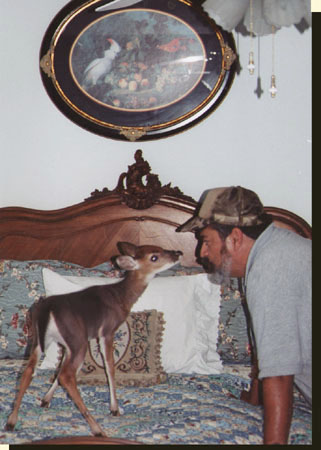A pet deer will, bit
by bit, relinquish some of its profoundly wild instincts as it is tamed.
An animal that is imprinted (using the word loosely) on humans
will allow a person into its most intimate, personal space, and will allow
very familiar physical contact. An animal that is merely hand-tame
will allow closeness usually only to accept food or limited petting, and
it would bolt off in a panic if you, for example, tried to hug it.
Many wild animals'
personal spaces shrink with familiarity. They might know that a particular
dog never behaves in a predatory way, and so pay little attention to it.
A tolerant , pen raised deer might accept a distance of, say,
20 feet between itself and its caretaker, but have a stranger come along
with the caretaker and the deer will blast off in a panic. Or, if
the familiar person tries to close that 20 feet to 15 feet, the deer's
flight response will kick in with full force. Finally, a completely
wild
animal will have its natural, unadulterated "flight distance". Just
as humans have their own personal space that, if intruded upon, will make
them feel crowded and alarmed, other species as well have their own typical
distance that, if trespassed upon, will trigger flight. For the whitetail
this distance is 200 feet, while for the pronghorn for example it is 500
feet.
Tame bucks though,
because
they are tame, can be killers. In the wild a buck has an intense
need to preserve its own flight distance, and would not think of coming
close to a human, and that is exactly what gives us our protection. Once
that need for distance is gone, the aggressive, rutting buck (even more
so if a person happens to come between the buck and a doe he is courting)
has no sense of needing to preserve its space, and that is when he becomes
seriously dangerous.
The force of a buck
attack is nearly unbelievable. I was the target of one when I used
a tractor to enter the pen of a normally very sweet, tame buck who was now in full
rut. Before this he had not been violent, but had been starting to
brush me with his velvety antlers as though he wanted to spar.
This is the tame,
rut-crazy buck who attacked the tractor. Here he is still in velvet
and still sweet natured. He is an expert at opening this gate, and
that is why you see the second, backup chain below. He latched onto
the wrong chain at first, but then finally realized it and grabbed the
right one. It will only be a minute until he has undone the lock.
|
Now in hard horn he
was in a frenzy. He gored the tractor tires repeatedly, then just
dug in and wrestled the machine. His muscles twisted, wrenched and
pulsed, trying to defeat the tractor. Witnessing his violent power,
I felt I was caught up in a phenomenon of nature like a hurricane. He would not slow down
or stop, and I could not leave the field because I would not be able to
to get down to open the gate safely, much less keep him in his pasture.
I finally had to bully the poor buck with the tractor bucket...for quite
a while...before he would concede the match and back off. If a fawn is picked
up the wrong way, it will use it's pointed hooves, and twiggy little legs
to connect with a power that would shock you...it will shred your
clothing and cover you with welts, lacerations and bruises. Compare
that to the large, thickly muscled hindquarters of an adult buck that he
uses to drive forward his multiply pointed weapon. Keep
in mind that a buck in rut, or to be safe ANY buck in hard horn is a crazed, hormone driven breeding machine. A large number of people
are killed by their trusted tame deer each year because they do not understand
the extremes in the nature of the normal breeding buck.
|



